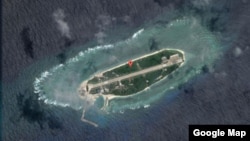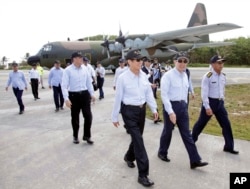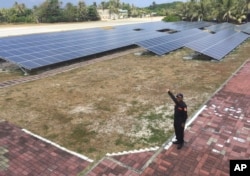Google says it is reviewing a request from Taiwan to blur satellite images of the government’s chief islet in the South China Sea.
A Google spokesperson told the VOA Thursday it “takes security concerns very seriously” and is “always willing to discuss them with public agencies and officials.” But Google indicated conversations with governments have never led to the blurring of images.
Google Earth shows the 1,400-by-400-meter islet in clear view, including an airstrip, pier and three small clusters of buildings.
Taiwan’s coast guard, which helps patrol the island known as both Itu Aba and Taiping, said in its own statement Thursday that because "Taiping is an important militarily jurisdiction, some related infrastructure on the island is in a state of alertness."
Google displays recent satellite images of the world through its "Google maps" and "Google earth" software products. Many other sensitive government installations, such as the CIA, NSA and Russia's federal security service headquarters are all displayed without blurring.
No further comment
Taiwanese officials would not make further comment on their request to Google, but analysts say the government wants to hide whatever’s there, old or new, because of intensified scrutiny of its claims since a U.N.-backed court weighed in on the South China Sea territorial dispute.
On July 12, an international tribunal of the world’s Permanent Court of Arbitration in The Hague ruled that the historical basis of Beijing’s claims to almost the entire South China Sea was legally invalid. Taiwan uses nearly the same basis to call the sea spanning 3.5 million square kilometers (1.4 million square miles) its own.
Brunei, Malaysia, Vietnam and the Philippines claim parts of the South China Sea near their coasts and continental shelves. The Philippines filed for arbitration in 2013.
Taiping is the sea’s largest of about 500 islets, and Taiwan may be nervous about other claimants seeing what’s there, analysts say. The government says it operates a 10-bed hospital, a lighthouse and $129 million worth of solar panels along with a small military airport.
“Any tangible new construction or developments certainly will create concerns and responses from the United States particularly,” said Andrew Yang, secretary general with the Chinese Council of Advanced Policy Studies think tank in Taiwan.
The United States, Taiwan’s strongest de facto ally, values the South China Sea for its freedom of navigation and has urged claimants to respect the arbitration ruling.
Taiwan's intentions
Some other governments might have already indicated suspicions that Taiwan is using the islet for hostile purposes, prompting the request to Google, said Alexander Huang, strategic studies professor at Tamkang University in Taiwan.
Taiwan had defended Taiping before July as a landform worthy of an ocean exclusive economic zone. The arbitration court said it should not offer such a zone.
“Unless other countries can prove it’s an aggressive deployment or construction that’s hurting other countries’ interests, then it would be hard for any party to file protests or make meaningful assessment,” Huang said.
China's suspicions
China is also leery of Taiwan’s offshore activities as relations between the two old political rivals have slipped since President Tsai Ing-wen took office in Taipei in May advocating a cautious approach to the Communist superpower.
Tsai’s government may have asked Google to block imagery as a public relations gambit at home, as well, analysts say. Tsai’s approval ratings have fallen from as high as 70 percent in May to around 50 percent and pollsters say her perceived lack of foreign policy laurels was a reason.
“Partly it’s domestic pressure, because it’s becoming one of the criticisms over new government that government has ignored the (South China Sea) sovereignty issue,” Yang said. “The move by the government is to try to balance this negative image.”










